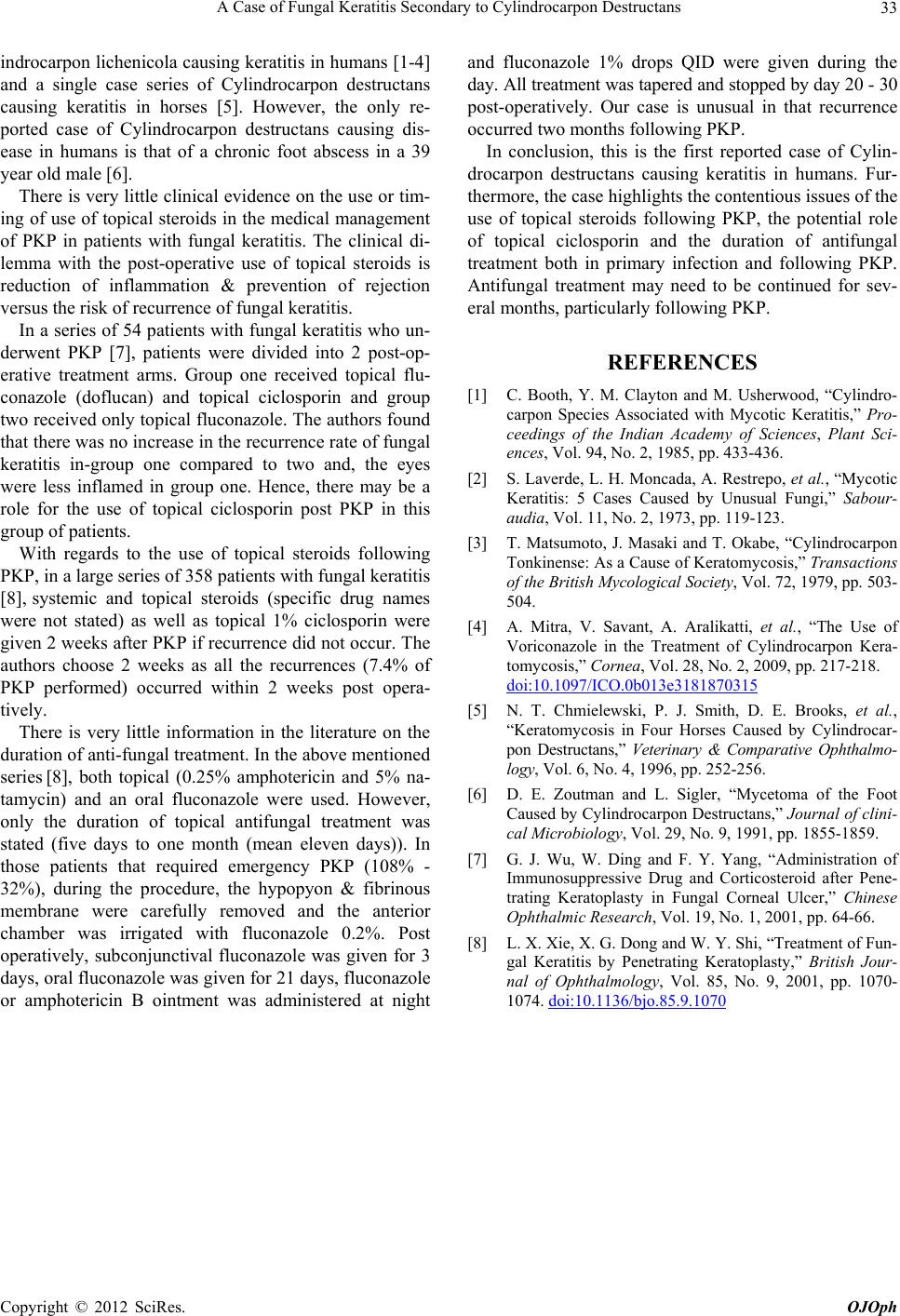
A Case of Fungal Keratitis Secondary to Cylindrocarpon Destructans
Copyright © 2012 SciRes. OJOph
33
indrocarpon lichen icola causing keratitis in humans [1-4]
and a single case series of Cylindrocarpon destructans
causing keratitis in horses [5]. However, the only re-
ported case of Cylindrocarpon destructans causing dis-
ease in humans is that of a chronic foot abscess in a 39
year old male [6].
There is very little clinical evidence on the use or tim-
ing of use of topical steroids in the medical management
of PKP in patients with fungal keratitis. The clinical di-
lemma with the post-operative use of topical steroids is
reduction of inflammation & prevention of rejection
versus the risk of recurrence of fungal keratitis.
In a series of 54 patients with fungal keratitis who un-
derwent PKP [7], patients were divided into 2 post-op-
erative treatment arms. Group one received topical flu-
conazole (doflucan) and topical ciclosporin and group
two received only topical fluconazole. The authors found
that there was no increase in the recurrence rate of fungal
keratitis in-group one compared to two and, the eyes
were less inflamed in group one. Hence, there may be a
role for the use of topical ciclosporin post PKP in this
group of patients.
With regards to the use of topical steroids following
PKP, in a large series of 358 patients with fungal keratitis
[8], systemic and topical steroids (specific drug names
were not stated) as well as topical 1% ciclosporin were
given 2 weeks after PKP if recurrence did not occur. The
authors choose 2 weeks as all the recurrences (7.4% of
PKP performed) occurred within 2 weeks post opera-
tively.
There is very little information in the literature on the
duration of anti-fungal treatment. In the above mentioned
series [8], both topical (0.25% amphotericin and 5% na-
tamycin) and an oral fluconazole were used. However,
only the duration of topical antifungal treatment was
stated (five days to one month (mean eleven days)). In
those patients that required emergency PKP (108% -
32%), during the procedure, the hypopyon & fibrinous
membrane were carefully removed and the anterior
chamber was irrigated with fluconazole 0.2%. Post
operatively, subconjunctival fluconazole was given for 3
days, oral fluconazole was given for 21 days, fluconazole
or amphotericin B ointment was administered at night
and fluconazole 1% drops QID were given during the
day. All treatment was tapered and stopped by day 20 - 30
post-operatively. Our case is unusual in that recurrence
occurred two months following PKP.
In conclusion, this is the first reported case of Cylin-
drocarpon destructans causing keratitis in humans. Fur-
thermore, the case highlights the contentious issues of th e
use of topical steroids following PKP, the potential role
of topical ciclosporin and the duration of antifungal
treatment both in primary infection and following PKP.
Antifungal treatment may need to be continued for sev-
eral months, particularly following PKP.
REFERENCES
[1] C. Booth, Y. M. Clayton and M. Usherwood, “Cylindro-
carpon Species Associated with Mycotic Keratitis,” Pro-
ceedings of the Indian Academy of Sciences, Plant Sci-
ences, Vol. 94, No. 2, 1985, pp. 433-436.
[2] S. Laverde, L. H. Moncada, A. Restrepo, et al., “Mycotic
Keratitis: 5 Cases Caused by Unusual Fungi,” Sabour-
audia, Vol. 11, No. 2, 1973, pp. 119-123.
[3] T. Matsumoto, J. Masaki and T. Okabe, “Cylindrocarpon
Tonkinense: As a Cause of Keratomycosis,” Transactions
of the British Mycological Society, Vol. 72, 1979, pp. 503-
504.
[4] A. Mitra, V. Savant, A. Aralikatti, et al., “The Use of
Voriconazole in the Treatment of Cylindrocarpon Kera-
tomycosis,” Cornea, Vol. 28, No. 2, 2009, pp. 217-218.
doi:10.1097/ICO.0b013e3181870315
[5] N. T. Chmielewski, P. J. Smith, D. E. Brooks, et al.,
“Keratomycosis in Four Horses Caused by Cylindrocar-
pon Destructans,” Veterinary & Comparative Ophthalmo-
logy, Vol. 6, No. 4, 1996, pp. 252-256.
[6] D. E. Zoutman and L. Sigler, “Mycetoma of the Foot
Caused by Cylindrocarpon Destructans,” Journal of clini-
cal Microbiology, Vol. 29, No. 9, 1991, pp. 1855-1859.
[7] G. J. Wu, W. Ding and F. Y. Yang, “Administration of
Immunosuppressive Drug and Corticosteroid after Pene-
trating Keratoplasty in Fungal Corneal Ulcer,” Chinese
Ophthalmic Research, Vol. 19, No. 1, 2001, pp. 64-66.
[8] L. X. Xie, X. G. Dong and W. Y. Shi, “Treatment of Fun-
gal Keratitis by Penetrating Keratoplasty,” British Jour-
nal of Ophthalmology, Vol. 85, No. 9, 2001, pp. 1070-
1074. doi:10.1136/bjo.85.9.1070